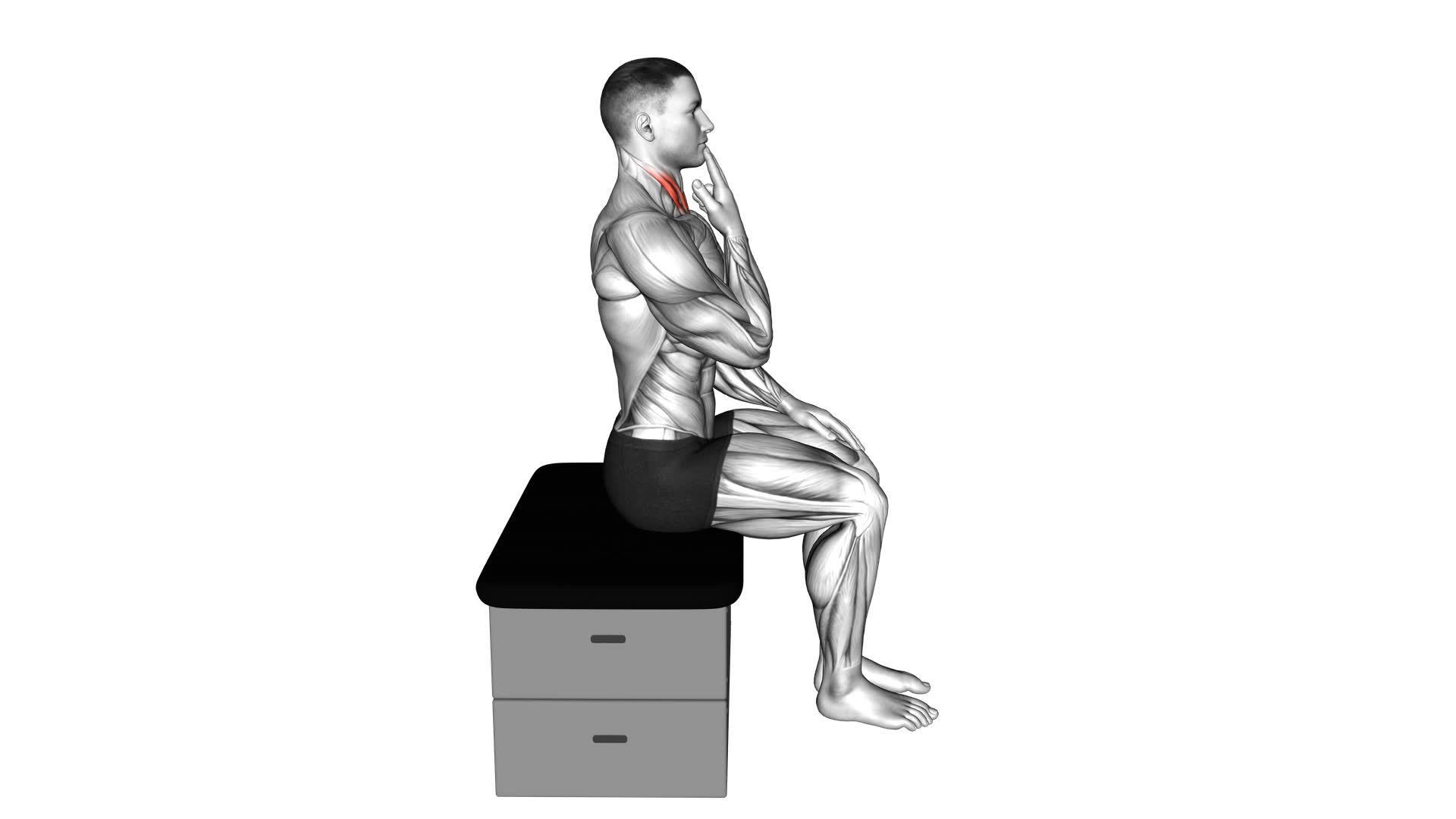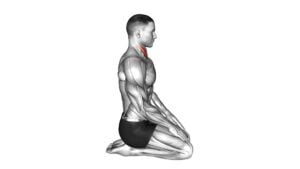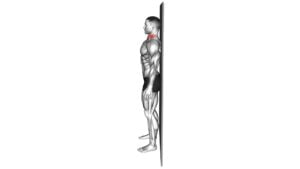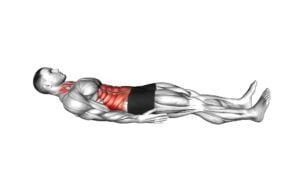Seated Chin Tuck (VERSION 2) – Video Exercise Guide & Tips

Are you looking for a simple exercise to improve your posture and reduce neck pain? Look no further than the Seated Chin Tuck!
Watch This Exercise Video
In this video exercise guide, we'll show you the proper technique for performing the Seated Chin Tuck and give you tips for avoiding common mistakes.
Whether you're a beginner or an experienced fitness enthusiast, this exercise can easily be incorporated into your routine for maximum benefits.
Let's get started!
Key Takeaways
- Seated Chin Tuck improves posture and aligns the head and neck
- It helps reduce neck and upper back pain
- The exercise can relieve tension headaches
- Seated Chin Tuck enhances breathing and overall neck and spine flexibility
Benefits of the Seated Chin Tuck
There are 5 key benefits of performing the Seated Chin Tuck exercise.
This exercise is highly effective in improving posture and reducing neck pain. By consistently practicing the Seated Chin Tuck, you can achieve a better alignment of your spine and neck, leading to improved posture. This exercise specifically targets the muscles responsible for maintaining proper posture, such as the deep neck flexors and the upper back muscles.
As you perform the Seated Chin Tuck, you'll notice a reduction in neck pain. This exercise helps to alleviate tension and stress in the neck muscles, which are often overworked due to poor posture or prolonged periods of sitting. The Seated Chin Tuck also promotes better blood circulation to the neck area, which can help to reduce inflammation and discomfort.
Additionally, the Seated Chin Tuck exercise helps to strengthen the muscles in your neck and upper back. This increased strength provides better support for your head and neck, reducing the risk of strain or injury. The exercise also enhances flexibility in the neck, allowing for a wider range of motion and improved overall function.
Proper Technique for the Seated Chin Tuck
To perform the Seated Chin Tuck exercise correctly, engage your core muscles and maintain a neutral spine position. This exercise is highly effective in improving posture and reducing neck pain. Follow these steps for proper technique:
- Sit in an upright position with your feet flat on the floor.
- Gently tuck your chin in towards your chest, creating a double chin.
- Keep your eyes focused straight ahead and avoid tilting your head down.
- Hold the position for a few seconds while maintaining a relaxed jaw.
- Slowly release the chin tuck and return to the starting position.
Engaging your core muscles throughout the exercise will help stabilize your spine and maintain proper alignment. By practicing the Seated Chin Tuck regularly, you can strengthen the muscles that support your neck and upper back, leading to improved posture. This exercise also helps to alleviate tension and discomfort in the neck, reducing neck pain and stiffness.
Remember to perform the Seated Chin Tuck with control and precision. Avoid any jerky or sudden movements that may strain your neck. Start with a few repetitions and gradually increase as your strength and flexibility improve. Consistency is key for achieving the best results in posture improvement and neck pain reduction.
Common Mistakes to Avoid
To ensure proper technique and maximize the benefits of the Seated Chin Tuck exercise, it's important to be aware of common mistakes to avoid.
One common mistake is failing to maintain proper form throughout the exercise. It's crucial to keep your neck and back straight while sitting upright in a chair. This will help to engage the correct muscles and prevent strain or injury.
Another common mistake is allowing the head to tilt too far back during the chin tuck. This can put excessive pressure on the neck and may lead to discomfort or pain. Instead, focus on gently tucking your chin towards your chest while keeping the rest of your body in a stable position.
Additionally, rushing through the exercise or performing it with jerky movements is a common mistake to avoid. The Seated Chin Tuck should be done in a slow and controlled manner, allowing the muscles to fully engage and stretch. Take your time and focus on the proper form to ensure maximum effectiveness.
By being aware of these common mistakes and avoiding them, you can ensure that you're getting the most out of the Seated Chin Tuck exercise.
Now, let's move on to the next section for some tips on how to progress and vary this exercise.
Tips for Progression and Variation
To progress and vary the Seated Chin Tuck exercise, you can incorporate different resistance levels or add additional movements. Here are some progression tips and variation ideas to keep challenging yourself:
- Increase Resistance: Use resistance bands or weights to add difficulty to the exercise. This will engage your neck and upper back muscles even more, promoting strength and stability.
- Dynamic Movements: Instead of holding the chin tuck position, you can incorporate dynamic movements such as slow head nods or side-to-side rotations. This will improve your range of motion and flexibility in the neck.
- Decline Bench: Performing the Seated Chin Tuck on a decline bench will increase the intensity of the exercise. This variation helps target the muscles from a different angle, providing a new challenge.
- Single-Leg Variation: Lift one leg off the ground while performing the Seated Chin Tuck. This not only adds difficulty but also engages the core muscles, enhancing overall stability and balance.
- Pulse Technique: After holding the chin tuck position, you can add small pulses by slightly moving your head up and down. This technique increases muscle activation and helps build endurance.
Incorporating the Seated Chin Tuck Into Your Routine
Incorporate the Seated Chin Tuck into your routine by following these tips and variations to continue challenging yourself and making progress.
Regular stretching is important for maintaining flexibility and preventing muscle imbalances. By incorporating the Seated Chin Tuck into your routine, you can reap the benefits of regular stretching, as it helps to lengthen and strengthen the muscles in the neck and upper back.
In addition to stretching, the Seated Chin Tuck also promotes good posture. Maintaining good posture is essential for overall spinal health and preventing musculoskeletal disorders. By regularly practicing the Seated Chin Tuck, you can strengthen the muscles that support the spine and improve your posture.
To incorporate the Seated Chin Tuck into your routine, start by sitting upright with your feet flat on the ground. Gently tuck your chin in towards your chest, keeping your neck and shoulders relaxed. Hold this position for a few seconds, then release. Repeat this exercise several times throughout the day, gradually increasing the duration of each hold to challenge yourself.
Remember to listen to your body and avoid any pain or discomfort. If you have any existing neck or back conditions, it's important to consult with a healthcare professional before incorporating the Seated Chin Tuck into your routine.
Frequently Asked Questions
Can the Seated Chin Tuck Exercise Help Reduce the Appearance of a Double Chin?
The seated chin tuck exercise can be effective in reducing the appearance of a double chin. By engaging the muscles in your neck and jaw, this exercise helps to strengthen and tone the area. Performing the seated chin tuck regularly can lead to improved muscle definition and a more defined jawline.
Incorporating this exercise into your routine, along with other targeted exercises, can enhance the overall benefits and effectiveness of the seated chin tuck.
Is the Seated Chin Tuck Exercise Safe for People With Neck or Spinal Issues?
The seated chin tuck exercise is a great option for people with neck or spinal issues. It can help strengthen the muscles in your neck and improve your posture.
How Often Should I Perform the Seated Chin Tuck Exercise for Optimal Results?
To achieve optimal results with the seated chin tuck exercise, it's important to consider how long you should hold the position. Holding the position for 5-10 seconds and repeating it 10-15 times, 2-3 times a day, can help you attain the best outcomes.
The seated chin tuck exercise is beneficial for improving posture and strengthening the neck muscles. It can be easily incorporated into your daily routine, even while sitting at a desk.
Additionally, you might be wondering if you can do this exercise while sitting at a desk. The answer is yes! The seated chin tuck exercise can be done while sitting at a desk, making it convenient to incorporate into your workday.
Can the Seated Chin Tuck Exercise Help Improve Posture?
The seated chin tuck exercise is an effective way to improve your posture and neck alignment.
By regularly performing this exercise, you can strengthen the muscles in your neck and upper back, leading to improved postural alignment.
This exercise specifically targets the muscles responsible for maintaining proper posture, helping you develop a more upright and aligned position.
Incorporating the seated chin tuck exercise into your routine will contribute to better posture and overall musculoskeletal health.
Are There Any Modifications or Alternatives to the Seated Chin Tuck Exercise for Those With Limited Mobility?
If you have limited mobility and are looking for alternatives or modifications to the seated chin tuck exercise, there are a few options available.
You can try performing a standing chin tuck against a wall or using your hand to provide gentle resistance.
Another option is to do a lying down chin tuck exercise, where you lie on your back and gently tuck your chin towards your chest.
These alternatives can help improve your posture and strengthen your neck muscles.
Conclusion
In conclusion, the seated chin tuck is a beneficial exercise for improving posture and relieving neck and upper back tension. By properly performing this exercise and avoiding common mistakes, you can effectively target the muscles responsible for maintaining good posture.
Furthermore, by incorporating the seated chin tuck into your routine and progressing gradually, you can achieve better results and potentially prevent future posture-related issues.

Author
Years ago, the spark of my life’s passion ignited in my mind the moment I stepped into the local gym for the first time. The inaugural bead of perspiration, the initial endeavor, the very first surge of endorphins, and a sense of pride that washed over me post-workout marked the beginning of my deep-seated interest in strength sports, fitness, and sports nutrition. This very curiosity blossomed rapidly into a profound fascination, propelling me to earn a Master’s degree in Physical Education from the Academy of Physical Education in Krakow, followed by a Sports Manager diploma from the Jagiellonian University. My journey of growth led me to gain more specialized qualifications, such as being a certified personal trainer with a focus on sports dietetics, a lifeguard, and an instructor for wellness and corrective gymnastics. Theoretical knowledge paired seamlessly with practical experience, reinforcing my belief that the transformation of individuals under my guidance was also a reflection of my personal growth. This belief holds true even today. Each day, I strive to push the boundaries and explore new realms. These realms gently elevate me to greater heights. The unique combination of passion for my field and the continuous quest for growth fuels my drive to break new ground.







